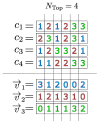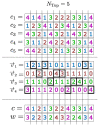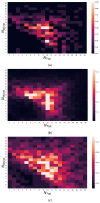A New Frequency Analysis Operator for Population Improvement in Genetic Algorithms to Solve the Job Shop Scheduling Problem
- PMID: 35746343
- PMCID: PMC9231246
- DOI: 10.3390/s22124561
A New Frequency Analysis Operator for Population Improvement in Genetic Algorithms to Solve the Job Shop Scheduling Problem
Abstract
Job Shop Scheduling is currently one of the most addressed planning and scheduling optimization problems in the field. Due to its complexity, as it belongs to the NP-Hard class of problems, meta-heuristics are one of the most commonly used approaches in its resolution, with Genetic Algorithms being one of the most effective methods in this category. However, it is well known that this meta-heuristic is affected by phenomena that worsen the quality of its population, such as premature convergence and population concentration in regions of local optima. To circumvent these difficulties, we propose, in this work, the use of a guidance operator responsible for modifying ill-adapted individuals using genetic material from well-adapted individuals. We also propose, in this paper, a new method of determining the genetic quality of individuals using genetic frequency analysis. Our method is evaluated over a wide range of modern GAs and considers two case studies defined by well-established JSSP benchmarks in the literature. The results show that the use of the proposed operator assists in managing individuals with poor fitness values, which improves the population quality of the algorithms and, consequently, leads to obtaining better results in the solution of JSSP instances. Finally, the use of the proposed operator in the most elaborate GA-like method in the literature was able to reduce its mean relative error from 1.395% to 0.755%, representing an improvement of 45.88%.
Keywords: combinatorial optimization; evolutionary algorithm; genetic algorithm; genetic improvement; job shop scheduling problem.
Conflict of interest statement
The authors declare no conflict of interest. The funders had no role in the design of the study; in the collection, analyses, or interpretation of data; in the writing of the manuscript; or in the decision to publish the results.
Figures






References
-
- Pardalos P.M., Du D.Z., Graham R.L. Handbook of Combinatorial Optimization. Springer; Berlin/Heidelberg, Germany: 2013.
-
- Sbihi A., Eglese R.W. Combinatorial optimization and green logistics. Ann. Oper. Res. 2010;175:159–175. doi: 10.1007/s10479-009-0651-z. - DOI
-
- James J., Yu W., Gu J. Online vehicle routing with neural combinatorial optimization and deep reinforcement learning. IEEE Trans. Intell. Transp. Syst. 2019;20:3806–3817.
-
- Matyukhin V., Shabunin A., Kuznetsov N., Takmazian A. Rail transport control by combinatorial optimization approach; Proceedings of the 2017 IEEE 11th International Conference on Application of Information and Communication Technologies (AICT); Moscow, Russia. 20–22 September 2017; pp. 1–4.
-
- Ehrgott M., Gandibleux X. Multiple Criteria Optimization: State of the Art Annotated Bibliographic Surveys. Springer; Boston, MA, USA: 2003. Multiobjective combinatorial optimization—Theory, methodology, and applications; pp. 369–444.
MeSH terms
Grants and funding
LinkOut - more resources
Full Text Sources
Miscellaneous

